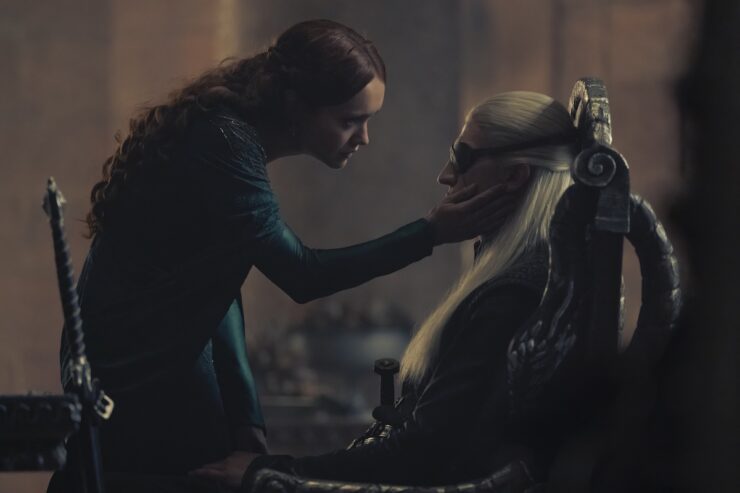Welcome back to our ongoing discussion of House of the Dragon, as we set the stage for the remaining two episodes of season two. Last night’s installment was an interesting case where book readers had a very different idea of what the episode would contain going in… It featured dragons, courtly intrigue, and the return of a season 1 MVP—all in a 67-minute runtime making it the second longest episode of the season. Let’s break it all down below, for those of you who don’t mind spoilers.
The Title
Episode 6 is called “Smallfolk,” which refers to a number of elements but most obviously to the food riot that breaks out after Rhaenyra sends supplies to the starving smallfolk of King’s Landing. It’s an interesting ploy and one that betrays the fundamental meaninglessness of the smallfolk to the nobles that rule them. I’ve been suspicious of both the Black and Green responses to their subjects ever since episode 9 of season 1, when Rhaenys (Eve Best) killed dozens of innocent people by bursting through the floor of the Dragonpit at Aegon’s coronation. In the latest episode, this new tactic on Rhaenyra’s part seems like a mercy until you remember that Aemond is in fact correct, and it is the Blacks’ blockade that is causing the smallfolk to starve in the first place. Of course, mismanagement of food and the feasting (more on that below) isn’t a good look for the Greens either. All in all, the smallfolk suffer the most during this war and neither side seems particularly interested in seeing them as anything more than pawns.
Of course, the show features a number of specific smallfolk who have been woven into the narrative. Sylvi (Michelle Bonnard) seems to have turned on Aemond (to whatever extent she cared about him in the first place, assuming she wasn’t simply doing her job) after he walked out on her when Aegon caught them in flagrante delicto. Or perhaps the show is hinging her renewed faith in Rhaeyra on the Hightowers’ lack of concern for her slow starvation. In either case, I do like that the show has used Sylvi and her brothel to connect most of the smallfolk that the Targaryens ignored: Dyana (Maddie Evans), the former serving girl who Aegon assaulted works there as a barmaid, and the place serves as Ulf’s (Tom Bennet) regular haunt. Now if only they could get Hugh (Kieran Bew) and Kat (Ellora Torchia) over to Sylvi’s, we’d have the complete set of named King’s Landing smallfolk characters collected in one place
And there is the further question of who counts as smallfolk in this narrative. Does Mysaria? She was sold into slavery but she has worked her way up to the right hand of the Queen. What about Addam and Alyn of Hull? They have lived their whole lives as smallfolk but are noble bastards who are at least partly acknowledged by their powerful father. Lastly, might we even look at someone like Ser Steffon Darklyn. He is undeniably nobly born, but when Rhaenyra says after his death that it was foolish to believe “a dragon would suffer a Darklyn to ride him,” she betrays a fundamental classist snobbery that the Targaryens are, in fact, more like gods than men—a distinction from what she once believed as a girl and communicated to her father way back in the very first episode.
Unraveling the Opening Credits
In addition to bringing back the scene of Vhagar and Arrax this week, there is a new panel in the opening credits which depicts the battle of Rook’s Rest. Much like the other panels’ propagandist takes on the events of the show, this one displays the battle as the surviving Greens would tell it—with King Aegon (Tom Glynn-Carney) holding his sword, Blackfyre, aloft triumphantly beside the corpses of Sunfyre and Meleys with Vhagar in the distance. All around him are burned and bloodied corpses. It makes for a nice contrast with Ser Criston’s (Fabien Frankel) horrified description of the battle to Alicent last episode.
We then see a second stain spreading through the tapestry. From Meleys’ embroidered head, black dragon blood now flows freely, mixing with the red. The loss of dragons is now a part of history’s tapestry.
The Westerlands and the Golden Tooth
The episode opens with Lord Jason Lannister (Tyland’s twin, also played by Jefferson Hall) arriving at the Golden Tooth and treating with Lord Humphrey Lefford (Daniel Fathers). The Golden Tooth is the seat of House Lefford and located in the far Northeast of the Westerlands. It serves as a checkpoint for those interested in entering that craggy region from the East, being built across a mountain pass.
In ASoIaF, House Lefford’s heraldry is a golden triangle (a “pile” in heraldic terminology) with the point facing upwards into a blue field with a golden sunburst. I had always assumed, because of this, that the term “Golden Tooth” referred to a mountain peak near the pass that accounted for the iconography. HotD has reversed the triangle, making it look much more like a serpent’s fang (or, more likely, a lion’s) while retaining the blue field and sunburst.
In addition to this, the western entrance to the castle features two huge stones with veins of gold running through them, set on pedestals. Both stones are unpolished, look natural, and resemble wisdom teeth with their long roots. I think we are meant to infer that these boulders, which likely once sat where the castle now stands, are the “golden teeth” for which the castle is named. It’s another great detail, full of thoughtful reference to Martin’s text, given to a minor castle whose role in the show is relatively unimportant. Compare that to the relatively uninspired (and wildly different from book descriptions) design of Casterly Rock, which we see, briefly, in the later seasons of Game of Thrones and you begin to get a sense of how HotD is putting a ton of their money into thoughtful design that was increasingly missing from GoT’s latter season. It’s not that they were completely careless or that the show looked bad—it’s just that you could really feel Benioff and Weiss’ relative boredom and lack of interest in details as they drew things to a close. Anyway, I love the teeth boulders!
Dragonlore and Dragonseeds
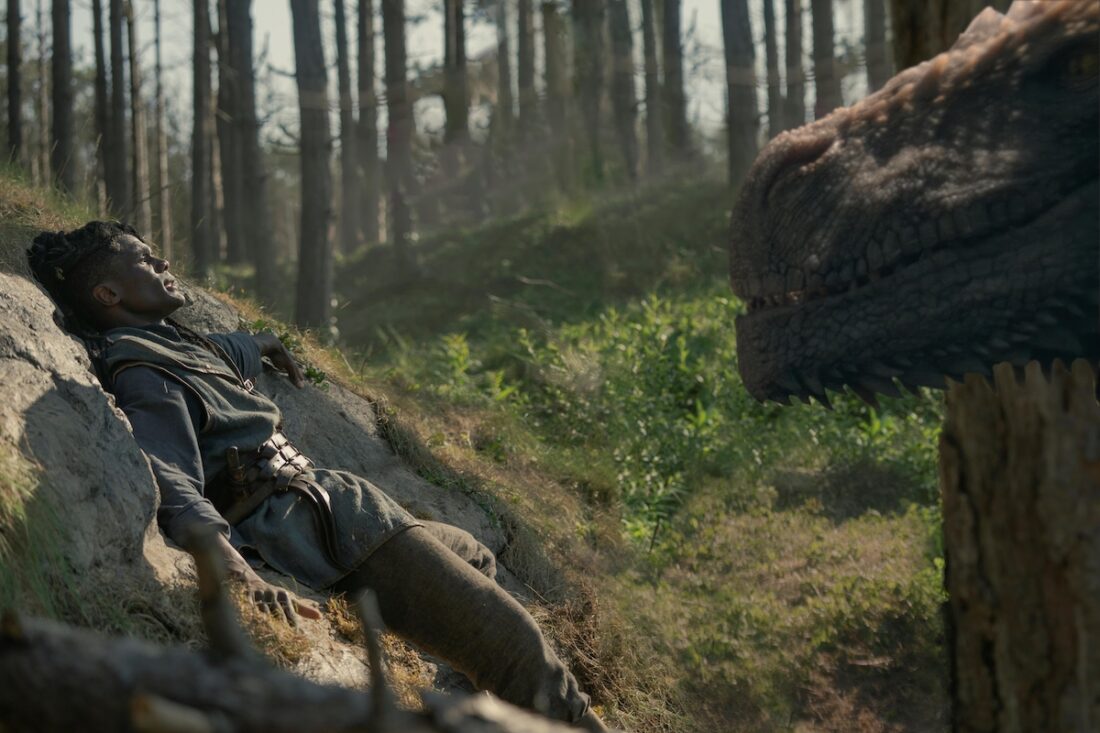
We haven’t gotten the full “Sowing of the Seeds” as described in Fire & Blood—remember that Vermithor and Silverwing, the dragons Jace mentioned last episode and Rhaenyra mentions to Ser Steffon Darklyn (Anthony Flanagan) still have no riders—but with the attempt and death of Ser Steffon and the ultimate success of Addam Of Hull (Clinton Liberty), we launch into a more complex version of what Martin’s Archmaester Gyldayn tells us of the attempt to find riders with some amount of dragonblood in their lineage to claim these dragons.
I spoke, in my episode 3 analysis, about the dragonseeds’ importance to dragonriding and the legend, now stated on the show, that only Valyrian dragonlords have a chance of making the bond. The Targaryens are the only clan of Dragonlords left in the known world, the other families having perished during the Doom. But exactly how much blood is needed (if it’s needed at all) is up for debate. Addam, being Corlys Velaryon’s bastard son, has about as much Targaryen blood as Ser Steffon; Aerion Targaryen, the father of Aegon the Conqueror was married to Valaena Velaryon and, given that the Velaryons (and the Celtigars and Baratheons) can all claim descent from Old Valyria, there is some through line of potential dragonlord blood that precedes the Doom.
But the end effect may be less about magic bloodlines and more about optics. As the “inside the episode” footage confirmed, this process of finding dragonriders is partly a democratizing of dragons across Westeros. Once a Darklyn or a Velaryon bastard or someone even less connected to the Targaryen line claims a dragon, the divine mystique of that Valyrian blood is lost. The Dying of the Dragons is not simply about their literal loss, it’s also about the death of Targaryen exceptionalism—and between this development and the parading of Meleys’ head through the streets last episode, we are seeing the first seeds of this shift.
Hightower Family Drama
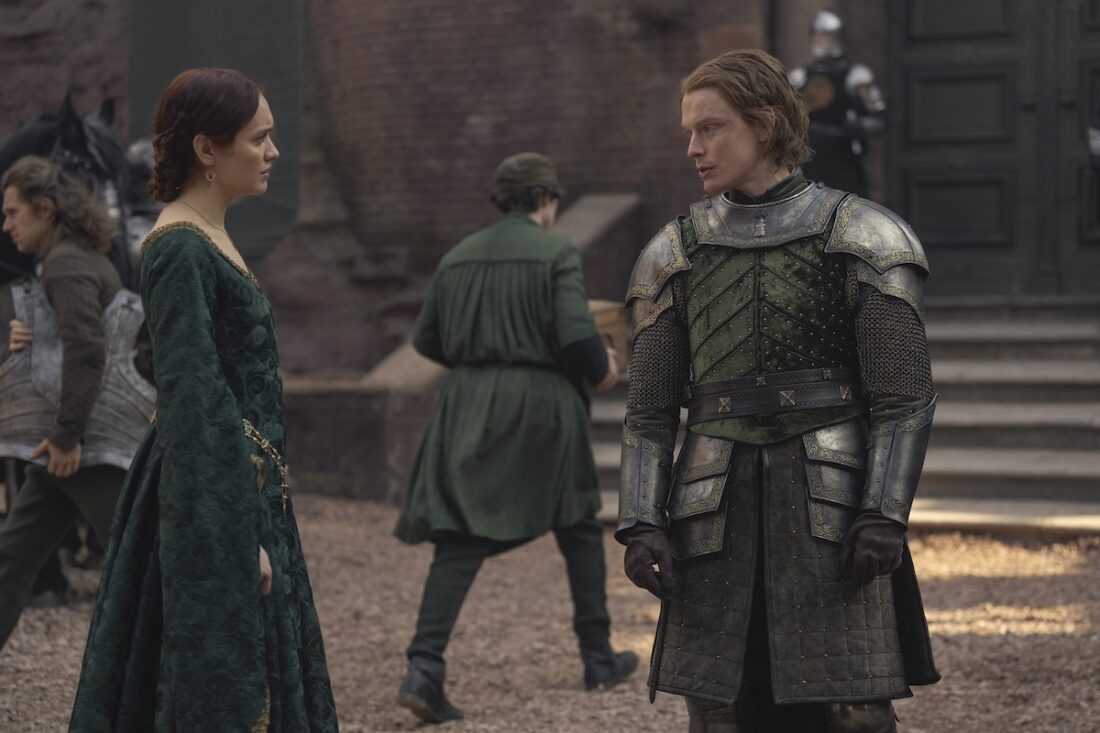
One of the best moments in the whole of the show is a scene in season 1, episode 5 where Otto Hightower (Rhys Ifans) warns Alicent (Emily Carey) that her children are in danger if Rhaenyra becomes queen. With an uncharacteristically raised voice he seethes that Alicent must either “prepare Aegon to rule or […] cleave to Rhaenyra and pray for her mercy” while she trembles and sobs as if she’s been struck. Having told his daughter that the closest friend she has ever had—a friendship he intentionally destroyed—will murder her children if given the chance, he draws Alicent into a tight embrace and then rides off, abandoning her for the next few years. It’s the perfect encapsulation of the broken childhood that Otto gifted his children. I wrote in my review of the season 1 finale that “at every turn, [Otto’s] loneliness has hardened his ambition and given him license to be quietly cruel.”
In this episode we get another classic, heartbreaking Alicent (Olivia Cooke) scene as she meets with her weary brother on his way out of King’s Landing. They speak about, albeit in an adumbrated fashion, the root of all the Hightower family drama: Alerie Florent. Otto Hightower’s dead wife is unnamed in F&B and Gyldayn doesn’t ever discuss the fact that the Hightower children grew up motherless (though it is also true that Alicent, being eleven years older in the book, did not lose her mother at quite so young an age). But the show, in naming her (back in episode one of this season) and calling more attention to the fact that it was, potentially, grief that made Otto Hightower such a bad parent, is borrowing one of Martin’s better plotlines from the original books. The dynamics are slightly different and much more toxic, but Martin makes it clear that the Lannister children have been deeply affected by the death of Joanna Lannister and that Tywin is a very different man than he was when they were married. This was played out a bit in the original series but this show seems to have heavily borrowed those tropes and made Gwayne (Freddie Fox) and Alicent deeply given over to growing up with a grief that was never allowed to be discussed.
Online dislike and distaste for Alicent has been intense and disappointingly—but perhaps unsurprisingly—more than a little sexist this season. I’m really glad the show is addressing (and perhaps dismissing) some of the common refrains about her unworthiness. Her pointed questioning of why Daeron is so much kinder than Aegon or Aemond—is it because he was raised outside of King’s Landing, or because he grew up without her?—feels like a direct rejoinder to the fans who think Alicent is unworthy of our pity because she hasn’t been a completely stellar mother. Martin has always been clear that King’s Landing is a terrible place for nobility to grow up, and this feels like as good a reason as any to acknowledge the possibility that, whether or not Alicent is a good parent, her children’s temperaments were, like so many things in her life, wildly out of her control.
DragonWatch
We get a new (if diminutive) dragon in last night’s episode, as well as our best look yet at a classic.
Stormcloud. We get a good look at the dragon of Rhaenyra’s fourth son, Aegon (yes, yet another Aegon–Archmaester Gyldayn refers to him as Aegon the Younger to distinguish between the two). Stormcloud has actually been aged down in the show. Aegon the Younger is supposed to be about ten during the events of the Dance and his dragon is large enough that he can be (badly and awkwardly) ridden. With Aegon being closer to three or four on the show, Stormcloud is also a hatchling and definitely too small to be ridden, even by a child. That is going to be an interesting change down the line, and book readers are probably curious about how it will be handled. Stormcloud’s coloration and physiology is not described in F&B but the show has opted to give him some dark grays trending to steely blues and dark teals that would seem to account for his name. He looks very much like Daenerys’ dragons in the first two seasons of GoT, implying that there is a more common infant form.
Seasmoke. Originally ridden by Laenor Velaryon, Seasmoke is probably on the younger side though we don’t have an exact age. He is somewhere north of 30 by the time of the show and has only ever had a single rider (at least until this episode). He is in a middling position in terms of size, being somewhat smaller than Caraxes and Meleys but still larger than Moondancer. He’s named for his coloration (F&B describes him as pale, silver gray) and that coloration has been retained in the show, alongside pale orange membranes and translucent horns. In many ways, Seasmoke looks the most like the dragons from the original show with a somewhat blunted muzzle, a spikier triple ridge of neck fins, a barrel chest, and a collection of smallish, back-curving horns at the base of the skull. Seasmoke is also more battle-tested than most dragons, having fought in the Stepstones with Laenor.
Disability and ASoIaF
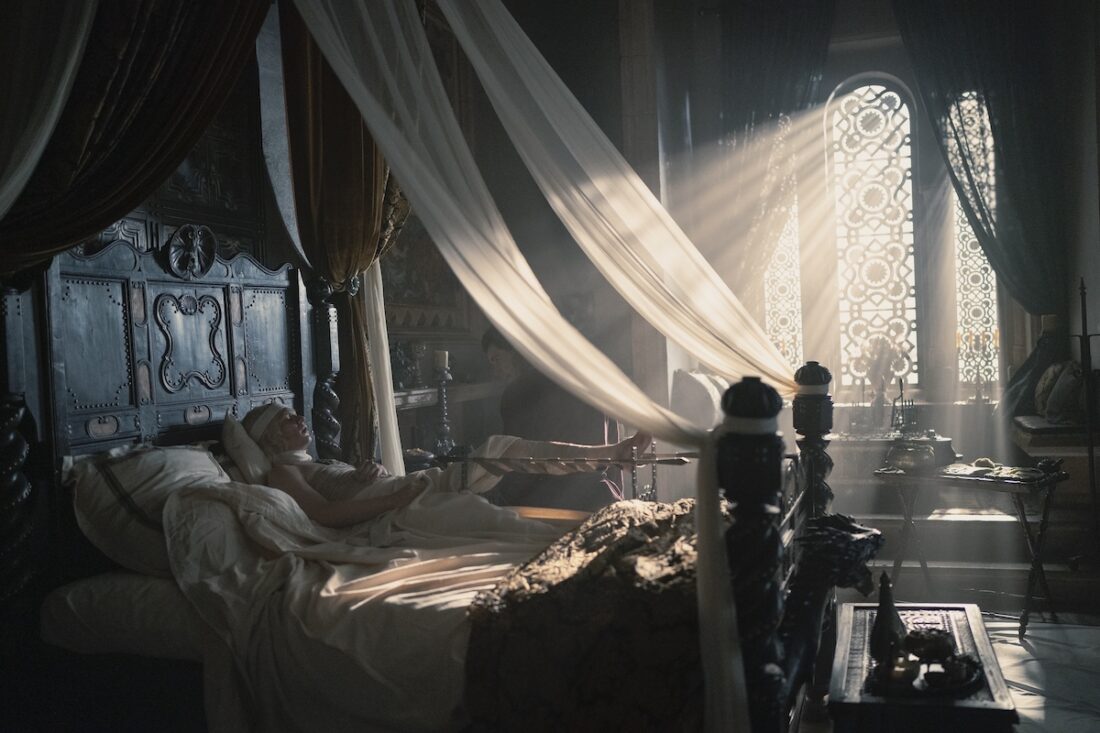
Larys Strong (Matthew Needham) approaches a newly conscious Aegon II to give him a hard lesson in what is in store for him, now that he is maimed. Martin has always had an in-book and in-life fondness for, as he puts it, “cripples, bastards, and broken things.” Martin places a huge number of people with disabilities at the center of his books; Bran, Tyrion, Catelyn, Jaime, Theon, Davos, and Jon Connington are all narrators with disabilities (a full third of the total roster to date) while Hodor, Doran Martell, the Hound, Maester Aemon, Varys, Elia Martell, Penny, Donal Noye, and Shireen Baratheon are all centrally important disabled characters—and even this list leaves out the huge number of tertiary and one-off characters to whom Martin assigns disabilities. It’s centrally important to the books and one of the places where the author’s empathy and understanding, largely free of pity or mockery, is most apparent.
In F&B, both Aegon and Larys are treated with a certain amount of contempt by Archmaester Gyldayn. Obviously, neither is a paragon of virtue that one can get truly get behind, but in spite of their faults, the show is eager to show the humanity underlying both characters. Larys reminds the audience that his clubfooot has always been a metonymy for his unworthiness in the eyes of others. His father always believed Larys was a victim of sorcery, and this carries over into his fellow courtiers’ fear of him, as he lurks around the edges of the Red Keep. It’s also interesting that Larys seemingly sides with Aegon here, given that Aemond is also disabled. That said, Aemond subscribes to the idea that Larys is conniving, going so far as to call Larys a toad immediately before this scene. While we, as an audience, shouldn’t discount Aemond’s disability, the show has used the eyepatch, the scar, and the sapphire in his socket as part of his design alongside his tightly cut tunic and long, flowing hair to make him into less of a figure of disability awareness and more of a cool anime villain. It’ll be worth watching how the show continues to deal with all three of these characters, specifically in terms of what others assume they lack.
Finally, a Bisexual Rhaenyra
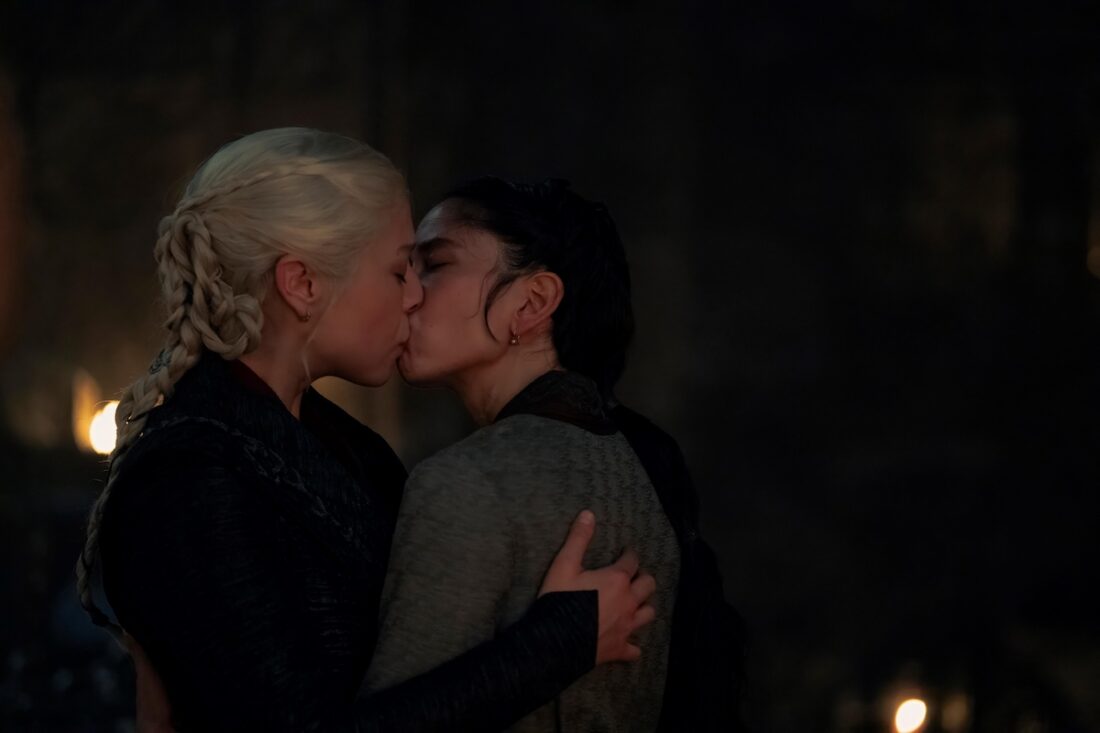
I’ve been joking with friends about how crazy it is that Emma D’Arcy is the most flirtatiously seductive person in Hollywood right now, yet they play one of the show’s most dour, serious, and un-flirtatious characters. Milly Alcock played Rhaenyra as occasionally coy, but D’Arcy’s adult version of the character is too stressed to bother. So it’s fantastic that the show finally gives her a moment of pure, unconstrained desire—even better that it makes the subtext of her queerness text. Obviously, I’m always going to ship Alicent and Rhaenyra but that also feels pretty impossible at this point in the war.
The very fact that the show is giving Rhaenyra a queer love story is pretty great. Martin was pretty progressive in his representations of queer characters when the first four books were released in the late ’90s and early 2000s. While he has always been clear on the existence and humanity of his queer characters, he has never made them the central focus of his stories and their sexuality has often been relegated to the realm of rumor or experimentation. Both Cersei and Daenerys have sexual experiences with women, which are described in the books but somewhat undercut by being characterized as exceptions to their general proclivities. There are no characters who strongly prefer lovers of the same sex and are either narrators or particularly forthcoming secondary characters. So it’s refreshing to see an ASoIaF show that makes its protagonist explicitly queer, and the tension and promise in the full thirty seconds of embrace that preceded the moment before she moves in to kiss Mysaria probably had the majority of the audience desperately anticipating whether or not it would actually happen.
I’m a little more uneasy about placing that moment directly after Mysaria reveals that her scar is the result of a violent abortion and attempted murder by her father. Obviously, the scene plays out that way in an attempt to show that Rhaenyra and Mysaria are both women who have been completely let down by men who should have cared for them. Rhaenyra, obviously, has only had one male lover that wasn’t a complete letdown as a person (and he was burned to death by his brother); I’m all for her expressing her sexuality more fully, partly as a result of realizing how little she has been supported by men. But, given Game of Thrones’ at best sketchy, at worst horrifying treatment of sexual assault as a plotline, I’m pretty leery of it being used here as a prelude to Mysaria expressing her interest in women. Obviously, HotD has been leagues better about its treatment of women than GoT, but there are always going to be a few twinges of worry when the show reminds us that Martin’s world is capable of stunning cruelty towards women. This episode’s writing is credited to Eileen Shim, Ti Mikkel gets the story credit, and about half of the writers’ room are women, so I trust that there are some tempering, thoughtful voices working hard to not repeat the mistakes of the earlier series. That said, we will have to see where the show takes their relationship and how it chooses to deal with Mysaria’s history of abuse.
Odds & Ends
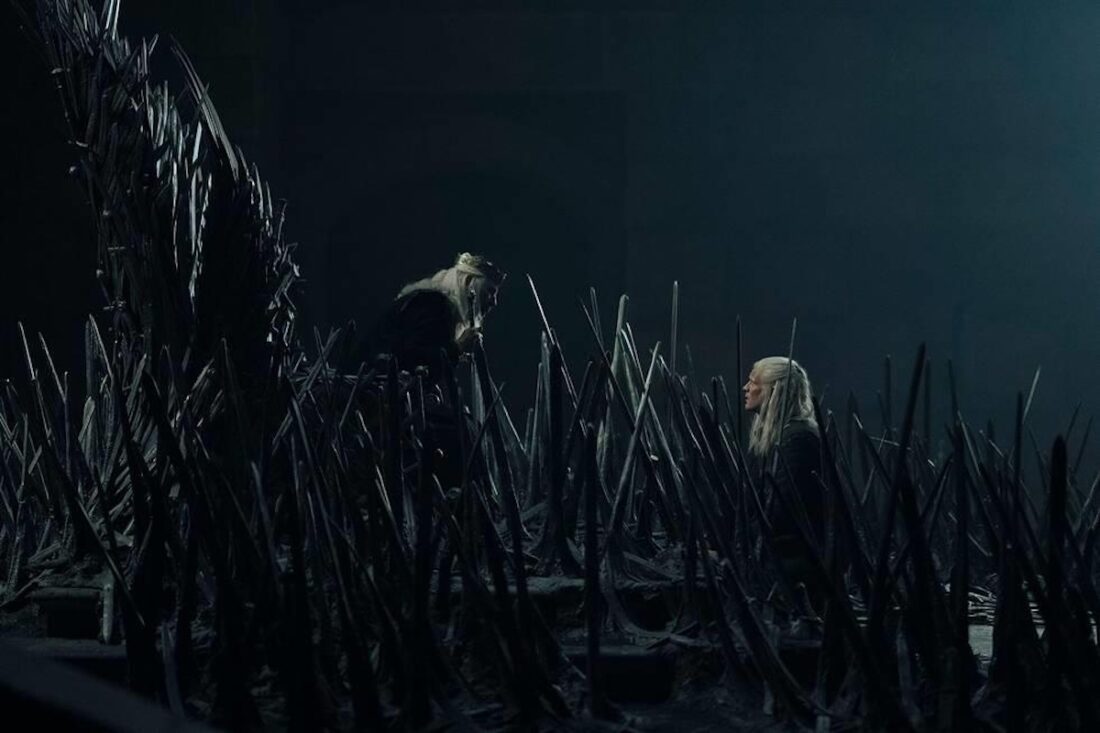
- I love Jason Lannister bringing caged lions with him into battle: some real Games Workshop regimental mascot vibes.
- Ironrod Wylde (Paul Kennedy) makes mention of Lord Dalton Greyjoy for the second time this season and uses his sobriquet, the Red Kraken. It is unclear if, like Daeron, this is setting him up to be part of the next season or if they will veer away from him as a player in the Dance, but he’s worth mentioning here. In F&B, Dalton Greyjoy is sixteen by the time of Viserys’ death and already an experienced reaver, sailor, and soldier. He wields the Valyrian steel longsword Nightfall, looted from a fallen foe during his years sailing as a mercenary in the Stepstones. He earned his nickname by emerging from a duel, fought to avenge his slain uncle, soaked in blood. He’s a dangerous ally who—like most of the Iron Islanders—is only barely loyal to the Seven Kingdoms and their monarchs.
- The Triarchy also gets a mention in this episode. I suspect that we will see more of them in future episodes but, as a quick refresher, they are an alliance of three of the Free Cities (Lys, Myr, and Tyrosh) who served as the enemy of the Seven Kingdoms during the war in the Stepstones at the beginning of last season when their war effort was led by Prince Craghas Drahar, the Crabfeeder (Daniel Scott-Smith). In the “This Season On…” trailer that played after the season 2 premiere, there were a couple of shots of Tyland Lannister that lead me to believe that a plot point of his, taken from much later in F&B, will be moved to the Stepstones and involve the Triarchy. For non-book readers, I’ll just leave it at that.
- I scoured the internet and the books but I can find no mention of Aeriana Darklyn née Targaryen. Rhaenyra states that she was Steffon Darklyn’s grandmother’s grandmother which (if we assume a generation to be twenty years or so, and that Ser Steffon is the same age as the actor that plays him) would roughly place Aeriana as being a princess just before Aegon’s conquest. There are a few unaccounted-for siblings from that time period who might have produced this Aeriana. Incidentally, while there are no Targaryens named Aeriana, it is clearly a distaff version of the popular Targaryen name Aerion—mentioned above as the father of Aegon the Conqueror and, later, Aerion “Brightflame,” who will appear on the currently filming spin-off series A Knight of the Seven Kingdoms (played by True Detective: Night Country’s Finn Bennet).
- I’m pretty sure that Gormon Massey (James Dreyfus) is constantly a little bit drunk at Rhaenyra’s small council meetings. While Alfred Broome rages and Bartimos Celtigar quietly patronizes, it’s really entertaining to see one small council member constantly attempting to just get through these meetings by passing as awake and alert enough to not draw attention.
- Always great to have Paddy Considine back as Viserys. It’s interesting that the show chooses to replay a conversation from season 1, episode 1—with Viserys only using the same lines from that conversation. But it’s absolutely different footage with a different line delivery. This has the effect of giving the scene a dream-like quality, a corrupted memory that’s not quite what we know to have actually occurred.
- Rhaena (Phoebe Campbell) comes across the burnt remains of a number of sheep in the Vale. This feels like a soft confirmation that they have given her a plotline that previously belonged to a character they have probably cut (more on that in the following weeks as we see how it plays out). I’m all for giving Rhaena more to do on the show (she’s important during the Dance, but far less so in the books than in the show) but there are some really great plot points with the potentially cut character that cannot be replicated with her. I hope that they find a way to split up that plot so that we don’t lose out on one of Martin’s more interesting denouements from the Dance.
- Lady Jeyne Arryn (Amanda Collin) mentions that a merchant cog, the Gay Abandon, is ready to take Baela, Aegon the Younger, and Viserys (the Younger) to Pentos. In F&B, it is only the younger children who are first in the Vale and then bound for the Free Cities on that self-same boat, so having Rhaenyra’s son Joffrey and Rhaena there is a change that feels like it’s going to have much larger repercussions than it may seem right now.
- It’s a nice little reveal that Alyn (Abubakar Salim) has been shaving his head in order to keep that Valyrian silver hair from showing. The Alyn of F&B is proud of his Velaryon status, so this is a new characterization for the show but it is drawn from a few instances across the ASoIaF books and related projects where a Targaryen shaves their head to hide that telltale coloration.
- As a side note, Salim is currently appearing on the current arc of Critical Role and he’s an absolute delight. Always nice to have the stars of nerdy fantasy shows be nerds themselves in their downtime!
- Grand Maester Orwyle (Kurt Egyiawan) tells Alicent that House Beesbury has rebelled against their liege lords, the Tyrells, in recompense for the murder of Lord Lymund Beesbury by Ser Criston last season—he’s the one who has his head bashed in by the stone ball that signals attendance at small council meetings in episode 9. It’s a little bit unclear how much the show will focus on the civil war in the Reach. It feels unlikely since there are precious few central characters involved in that particular conflict, but I would have said the same thing about the Blackwood/Bracken conflict before this season.
- I was deeply worried for Helaena during the food riot. The show has chosen to make her much more important and interesting than she was in F&B, which means that they really can do anything with her from here on out. I never trust this show to keep a minor character that they’ve made suddenly important safe for very long…
- The member of the Strong household that was accused of sorcery might have been Alys Rivers (Gayle Rankin). While she is usually considered to be Lyonel Strong’s (Gavin Spokes) bastard daughter, Gyldayn mentions that Mushroom believed that she was much older and served as a wetnurse to Larys and Harwin, possibly even to Lyonel himself. Either way, Larys’ cageyness about the “member of the household” and the vagueness about whether or not Alys is his half-sister or something else all points back at her general witchiness and potential immortality.
- We also get the great Sîan Brooke back this episode to play Aemma Arryn (albeit with no lines and potentially composited from archival footage). Still, it’s nice to have a sense of continuity and history by having dead characters be referenced and played by their original actors when appropriate.
- Mysaria, in being unable to have children, joins her fellow Free Cities-born Master of Whisperers, Lord Varys (Conleth Hill) as a character whose loyalty to the good of the realm cannot be poisoned by personal stakes within it. A strong legacy, through children, is the end goal of most Westerosi nobility and people excluded from that are, often, in Martin’s narrative, represented as selfless and dedicated to something grander than their stake in the game of thrones. Also, the reveal of her infertility and its cause makes Daemon’s joke, last season, that she was pregnant with his child, even more hideous.
In Conclusion
In many ways, the show is slowing down the pace of the book—to the point where I am actually less sure of where this season will end, now. I had a definite hunch about the season two finale that now seems like it’s not going to come to pass, given that we only have two episodes left. Either way, I’m excited for more Sowing of the Seeds and the eventual appearance of Vermithor and Silverwing. But what did you think of this latest installment? Is the pace of this season too slow for you? Are you enjoying the focus on character motivations this episode? Are you as excited for #Rhaesaria as you should be? Let me know below!










